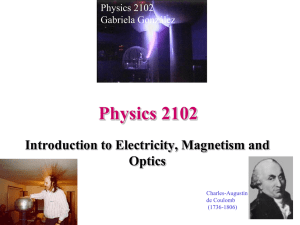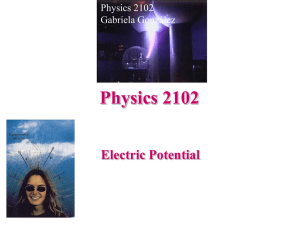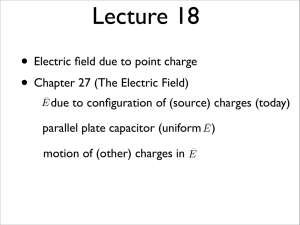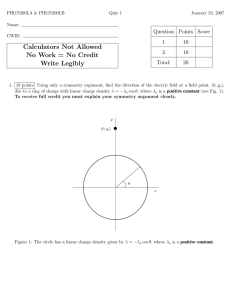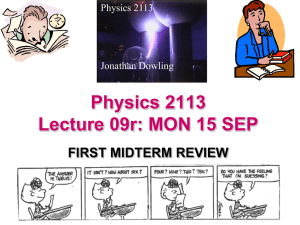Electric Field
advertisement
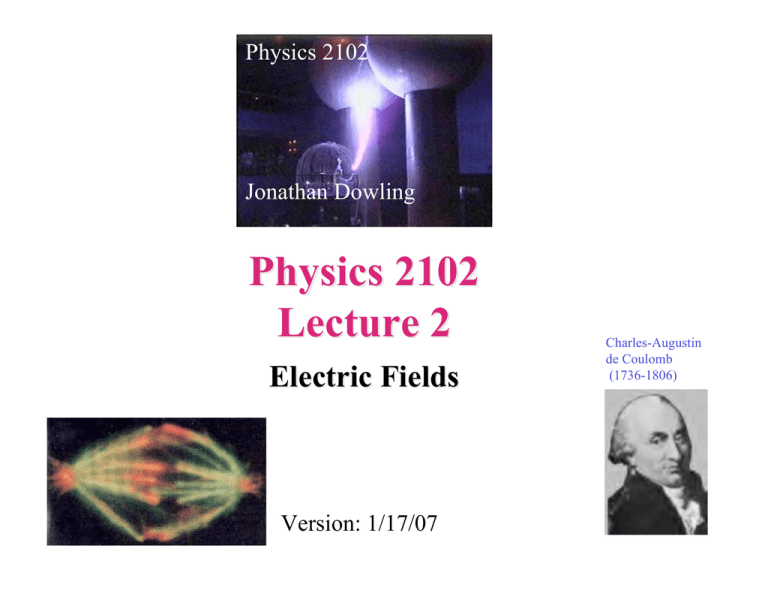
Physics 2102 Jonathan Dowling Physics 2102 Lecture 2 Electric Fields January 17, 07 Version: 1/17/07 Charles-Augustin de Coulomb (1736-1806) What are we going to learn? A road map • Electric charge Electric force on other electric charges Electric field, and electric potential • Moving electric charges : current • Electronic circuit components: batteries, resistors, capacitors • Electric currents Magnetic field Magnetic force on moving charges • Time-varying magnetic field Electric Field • More circuit components: inductors. • Electromagnetic waves light waves • Geometrical Optics (light rays). • Physical optics (light waves) Coulomb’s law + q1 F12 F21 r12 k | q1 | | q2 | | F12 |= 2 r12 !q2 For charges in a VACUUM 2 N m 9 8 . 99 ! 10 k= C2 Often, we write k as: k= 1 4$# 0 with # 0 = 8.85 " 10 !12 2 C N m2 Electric Fields • Electric field E at some point in space is defined as the force experienced by an imaginary point charge of +1 C, divided by 1 C. • Note that E is a VECTOR. • Since E is the force per unit charge, it is measured in units of N/C. • We measure the electric field using very small “test charges”, and dividing the measured force by the magnitude of the charge. Electric field of a point charge +1 C q E R k |q| | E |= 2 R Superposition • Question: How do we figure out the field due to several point charges? • Answer: consider one charge at a time, calculate the field (a vector!) produced by each charge, and then add all the vectors! (“superposition”) • Useful to look out for SYMMETRY to simplify calculations! Example Total electric field -2q +q • 4 charges are placed at the corners of a square as shown. • What is the direction of the electric field at the center of the square? -q y +2q (a) Field is ZERO! (b) Along +y (c) Along +x x Electric Field Lines • Field lines: useful way to visualize electric field E • Field lines start at a positive charge, end at negative charge • E at any point in space is tangential to field line • Field lines are closer where E is stronger Example: a negative point charge — note spherical symmetry Electric Field of a Dipole • Electric dipole: two point charges +q and –q separated by a distance d • Common arrangement in Nature: molecules, antennae, … • Note axial or cylindrical symmetry • Define “dipole moment” vector p: from –q to +q, with magnitude qd Cancer, Cisplatin and electric dipoles: http://chemcases.com/cisplat/cisplat01.htm Electric Field ON axis of dipole -q a +q P x Superposition : E = E+ + E! E+ = kq a# & $x' ! 2" % 2 & # $ ! 1 1 ! E = kq $ 2 2 $, a) , a) ! $* x - ' * x + ' ! 2( + 2( " %+ E' = ' = kq kq a# & $x+ ! 2" % 2 xa 2 #2 & 2 a $x ' ! $ ! 4 % " 2 Electric Field ON axis of dipole E = kq 2 xa 2 #2 & 2 a $x ' ! $ ! 4 % " = p = qa “dipole moment” -- VECTOR 2kpx 2 #2 & 2 a $x ' ! $ ! 4 % " - + What if x>> a? (i.e. very far away) 2kpx 2kp E! 4 = 3 x x r E! r p r 3 E~p/r3 is actually true for ANY point far from a dipole (not just on axis) Electric Dipole in a Uniform Field • Net force on dipole = 0; center of mass stays where it is. • Net TORQUE τ: INTO page. Dipole rotates to line up in direction of E. • | τ | = 2(QE)(d/2)(sin θ) = (Qd)(E)sinθ = |p| E sinθ = |p x E| • The dipole tends to “align” itself with the field lines. • What happens if the field is NOT UNIFORM?? Distance between charges = d Electric charges and fields We work with two different kinds of problems, easily confused: • Given certain electric charges, we calculate the electric field produced by those charges (using E=kqr/r3 for each charge) Example: the electric field produced by a single charge, or by a dipole: • Given an electric field, we calculate the forces applied by this electric field on charges that come into the field, using F=qE Examples: forces on a single charge when immersed in the field of a dipole, torque on a dipole when immersed in an uniform electric field. Continuous Charge Distribution • Thus far, we have only dealt with discrete, point charges. • Imagine instead that a charge Q is smeared out over a: Q Q – LINE – AREA – VOLUME • How to compute the electric field E?? Q Q Charge Density λ = Q/L • Useful idea: charge density • Line of charge: charge per unit length = λ • Sheet of charge: charge per unit area = σ • Volume of charge: charge per unit volume = ρ σ = Q/A ρ = Q/V Computing electric field of continuous charge distribution • Approach: divide the continuous charge distribution into infinitesimally small elements • Treat each element as a POINT charge & compute its electric field • Sum (integrate) over all elements • Always look for symmetry to simplify life! Example: Field on Bisector of Charged Rod • Uniform line of charge +Q spread over length L • What is the direction of the electric field at a point P on the perpendicular bisector? (a) Field is 0. (b) Along +y (c) Along +x • Choose symmetrically located elements of length dx • x components of E cancel P y a x dx o L dx q Example --Line of Charge: Quantitative • Uniform line of charge, length L, total charge Q • Compute explicitly the magnitude of E at point P on perpendicular bisector • Showed earlier that the net field at P is in the y direction -- let’s now compute this! P y a x o L Q Line Of Charge: Field on bisector Distance dE P Charge per unit length dx x o L q != L k (dq ) dE = 2 d a d! d = a2 + x2 Q k (! dx)a dE y = dE cos" = 2 (a + x 2 )3 / 2 a cos! = 2 2 1/ 2 (a + x ) Line Of Charge: Field on bisector L/2 L/2 dx ' $ x E y = k# a ! 2 2 3 / 2 = k( a % 2 2 2" ( a + x ) & a x + a # !L / 2 "L / 2 = 2k!L 2 2 a 4a + L What is E very far away from the line (L<<a)? What is E if the line is infinitely long (L >> a)? 2k!L 2k! Ey = = 2 a a L Example -- Arc of Charge: Quantitative • Figure shows a uniformly charged rod of charge −Q bent into a circular arc of radius R, centered at (0,0). • Compute the direction & magnitude of E at the origin. kdQ dE x = dE cos! = 2 cos! R Ex = " /2 ! 0 k ($Rd# ) cos# k$ = 2 R R k! Ex = R y 450 x y dQ = λRdθ dθ " /2 ! cos#d# 0 k! k! Ey = E= 2 R R θ x λ = 2Q/(πR) Example : Field on Axis of Charged Disk • A uniformly charged circular disk (with positive charge) • What is the direction of E at point P on the axis? z (a) Field is 0 (b) Along +z (c) Somewhere in the x-y plane P y x Example : Arc of Charge y • Figure shows a uniformly charged rod of charge -Q bent into a circular arc of radius R, centered at (0,0). • What is the direction of the electric field at the origin? x (a) Field is 0. • Choose symmetric elements (b) Along +y • x components cancel (c) Along -y Summary • The electric field produced by a system of charges at any point in space is the force per unit charge they produce at that point. • We can draw field lines to visualize the electric field produced by electric charges. • Electric field of a point charge: E=kq/r2 • Electric field of a dipole: E~kp/r3 • An electric dipole in an electric field rotates to align itself with the field. • Use CALCULUS to find E-field from a continuous charge distribution.
